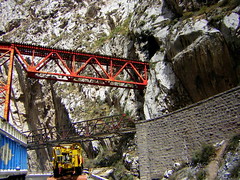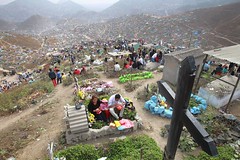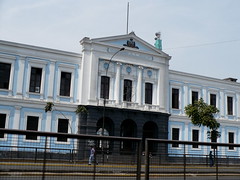The Central Railway of Peru
It’s among the most notable railways of the world and is unequalled in the technical difficulties overcome and the high elevation reached in its construction, climbing over the divide of the Andes from Callao to Huancayo in the department of Junín.
It’s also the only railway in South America that  tops the tremendous altitude of 4820m. In fact the highest point at La Cima is 4,835m above sea level. To reach this altitude, the train crosses 41 bridges, 60 tunnels and around 13 zig zags, taking approximately 8 hours up-hill to reach the Galera tunnel. From there it descends on the opposite side of the Andes, following the Yauli River which is on the Atlantic slope, to La Oroya. Then it follows the course of the Mantaro River, crossing it to reach Tambo station, passing through the centre of the valley and beautiful towns such as Jauja, Apata, Matahuasi, Concepcion and finally, Huancayo.
tops the tremendous altitude of 4820m. In fact the highest point at La Cima is 4,835m above sea level. To reach this altitude, the train crosses 41 bridges, 60 tunnels and around 13 zig zags, taking approximately 8 hours up-hill to reach the Galera tunnel. From there it descends on the opposite side of the Andes, following the Yauli River which is on the Atlantic slope, to La Oroya. Then it follows the course of the Mantaro River, crossing it to reach Tambo station, passing through the centre of the valley and beautiful towns such as Jauja, Apata, Matahuasi, Concepcion and finally, Huancayo.
Proposals
In 1851 the Polish engineer Ernesto Malinowski proposed to extend the Lima – Callao railway opened that year, to the Jauja Valley. The Government put together a commission to investigate the idea who then put forward a proposal for the work. Once their proposal had been approved, the Commission turned the project over to Malinowski.
In 1866 war broke out with a Spain desperate to reconquer its lost empire and work was suspended for 2 years, after which Henry Meiggs, a North American contractor in New Jersey and Chile was requested to oversee construction. His services didn’t come cheaply, and he wasn’t interested in the previous studies conducted. It is said that Meiggs made the statement that “I will locate the rails wherever the llamas go”. After approving Meiggs’ own studies, the Government accepted Meiggs’ proposal and Meiggs agreed to construct the railway between Lima and Jauja in 1869 within 6 years. Work began on the first of January, 1870 with a lavish ceremony in which the first stone was placed at the present-day Monserrate station in Lima under the direction of Malinowski, engineer and head of the Technical Committee.
Construction
To facilitate construction, the main line was divided into sections, which were:
- Lima – Callao – Cocachacra
- Cocachacra – San Bartolome – Surco
- Surco – Matucana
- Matucana – Parac
- Para – San Mateo – Rio Blanco
- Rio Blanco – Galera
- Galera – La Oroya
Meiggs was only able to immediately construct the line as far a Chicla, 141km from Callao, due to the Governments inability to provide all of the 27 million soles. Mieggs died a year before the war with Chile waiting for the Government to come up with the money. The line was only completed as far as La Oroya, after a suspension until 1890, by turning over all of the State railways to the bond holders of the Peruvian national debt after the war with Chile. The line reached Casapalca on 12 July 1892 and La Oroya on the 10 January 1893. In 1907 construction began of the section between La Oroya and Huancayo. When finished, it had taken more than 38 years to complete the Central Railway.
Photos –
Tags: 1800s, 1900s, callao, central railway, huancayo, juaja, junin, la oroya, lima, railway, rimac valley, train, war of the pacific






![The Streets of Cusco [Featured]](http://farm4.static.flickr.com/3425/3818103728_6d4e849cc9_m.jpg)



